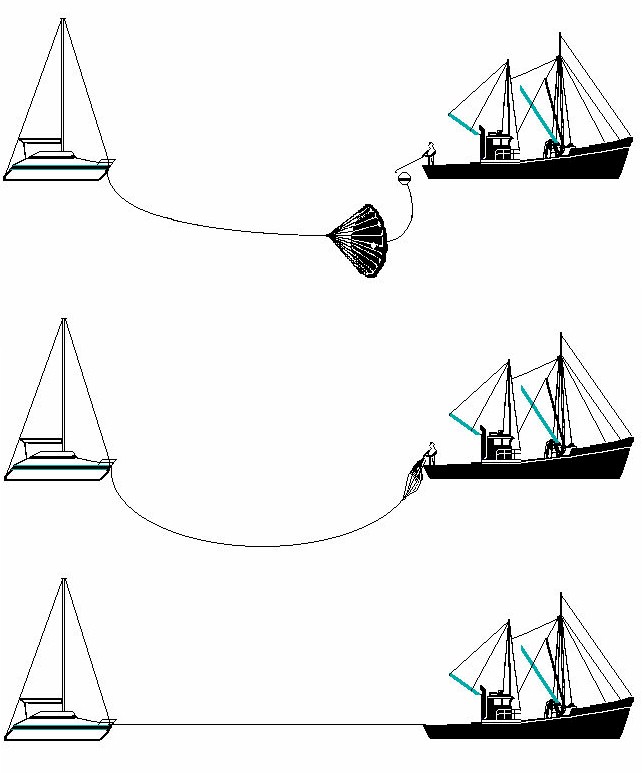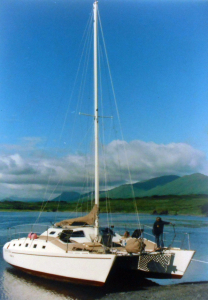S/C-8
Catamaran, Kelsall
36' x 20' x 4 Tons
18-Ft. Dia. Sea Anchor
Force 11-12 Conditions
File S/C-8, obtained from Rick Kazprzak, Kodiak, Alaska - Vessel name Catherine Estelle, hailing port Kodiak, "Tonga Tora" catamaran, designed by Derek Kelsall, LOA 36' x Beam 20' x Draft 18" x 4 Tons - Sea anchor: 18-ft. Diameter Para-Tech on 450' x 5/8" nylon three strand tether and bridle arms of 50' each, with 5/8" galvanized swivel - Partial trip line - De-ployed in a storm in the Gulf of Alaska about 350 miles west of Queen Charlotte Island, with winds of 70-80 knots and seas of 30-40 ft. - Vessel's bow yawed 10° - Drift was estimated to be about 5 n.m. during 48 hours at sea anchor.
Linda Kasprzak read the second edition of the DDDB and urged Rick to equip Catherine Estelle with a Para-Tech sea anchor. She also saw to it that tether, bridle, hardware and all fitting were ready to take on the Gulf of Alaska.
Rick and Linda Kasprzak left Kodiak on 13 July 1991, headed for Vancouver Island, 1200 miles as the crow flies straight across the Gulf of Alaska. At the half way point they ran into one major storm, one gale, and one minor gale, spending a total of five days tethered to the sea anchor. There were some anxious moments.
The transcript of an official Coast Guard document (CG Juneau, Archive Number 2285) reads as follows: Urgent Marine Information Broadcast - Communications have been lost with the S/V Catherine Estelle endangered by weather in position 53-05 N, 142-65 W. The vessel is a 37 ft. catamaran with 2 persons on board. Vessels in the vicinity are requested to keep a sharp lookout, assist if possible, and advise the nearest CG station.
At the time of this urgent broadcast Catherine Estelle was being held to survival by the long rode leading the Para-Tech sea anchor. Transcript:
The storm we encountered was a major one with a very quickly dropping barometer (1 millibar every 1/2 hour). At the height of the storm we encountered 35-40 ft. seas. I believe I am under-estimating this as the seas were so big that our GPS could not get a fix at times, because it was being blocked out by the huge waves.

Wind speed increased at the start from 40 to easily over 70 knots. The seas were nothing but white spray, breaking crests and huge waves. We have lived in Kodiak for 15 years and so have experienced many a storm, but have never seen anything like we experienced during those 48 hours. The situation was so bad that we were dressed in survival suits and had the catamaran ready so that if we flipped, we could have access to our EPIRB, survival food and water.
The boat handled very well, but it was unnerving to be held to survival by a thin 5/8" line. Sleep was impossible. The sea anchor definitely saved the boat and I'm sure our lives. It operated flawlessly on those 2 days and the other 3 days during the other 2 gales.
We had 50' bridle arms that went through a specially made SS bow plate, but we had also built a U-bolt to this plate. The bridle was encased in 1/4" thick rubber tubing where it hit metal on the plate. We had a little trouble deploying the sea anchor, mainly because we have a seagull striker in front, plus 2 head stays. But once around all that, we were able to set the anchor just fine. Our catamaran rode these huge seas like a duck rides a wave on the sea anchor. But because the seas were so big, we did have a lot of noise due to waves slapping on the under-body.
The bottom line is that the 18-ft. para-anchor operated as you said it would, and with your help, my wife Lin's forethought, and a well-designed boat, we all did what should have been done and came through a very violent storm and survived with NO damage. Mr. Kelsall must be commended on his fine design of this boat.
Rick & Linda Kasprzak have since logged thousands of miles and used the same sea anchor in other marginal situations. In a letter to your author dated 16 September 1991, Rick wrote about one other episode. At the time Catherine Estelle was beating against 30 knot winds and 10-15' seas when a big wave slammed into her. There was a loud bang. A frantic search revealed that a weld had broken on one of her rudders.
The sea anchor was immediately deployed to bring the situation under control and wait for calmer seas. A radio call to the Canadian Coast Guard brought a response from a nearby fishing boat, with an offer to tow the catamaran to Bella Bella (the nearest port).
In the radio conversation that followed, the skipper of the fishing boat expressed concern about the initial pick-up and transfer of tow line in rough seas. He said he had seen more damage occur in this transfer than in any other situation in all the towing experiences he knew of. Rick Kazperzak:
I said to the captain of the fishing boat, "No problem! Just pick up the trip line connected to the red buoy, pull the chute in, bag it temporarily on deck, then cleat the tether and start your tow."
The fisherman had no problem doing this. He towed Catherine Estelle to a small bay in Bella Bella, and then released the tow - dropped the parachute back in the water and went on his way. Rick Kasprzak:
The point is this: here is another safety use of the sea anchor - towing. Easy pick up of tow line and easy release.
NOTE: When it come to tow lines the Coast Guard will not go along with the above proposition. It has always been the policy of the US and Canadian Coast Guards to use nothing but their own tow lines in all operations. They will not tow a vessel with anything else because they don't want to be liable for failure of the rope - and damage or injury resulting from that failure. See also Captain Bob Proulx's Coast Guard experience in File S/M-23. However, the above proposition is eminently logical when receiving a tow from a friendly fishing boat or pleasure vessel.


Hi,
I’m from Alaska and I would very much appreciate knowing if you would send me Rick and Lindas’ email address, or if not, would you send my email address to them so as to correspond with them.
I’ve not found another way to get together with them.
I’m also a sailor and there are some things I’m interested in asking them considering their sailing experience..
Thank you,
Rudy Mallonee
Hi Rudy,
Unfortunately I don’t have a current contact address for them. However, I see that Catherine Estelle is listed for sale on http://www.yachtworld.com/boats/1990/Custom-Catamaran-2720193/La-Paz,-BCS/Mexico#.VAYMC2N_eaA This may be an old listing, but the broker should at least have contact details for them, so perhaps try him?